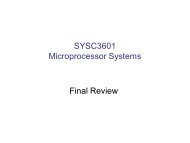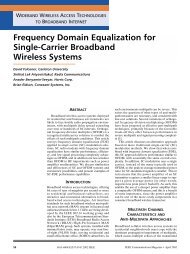Image Reconstruction for 3D Lung Imaging - Department of Systems ...
Image Reconstruction for 3D Lung Imaging - Department of Systems ...
Image Reconstruction for 3D Lung Imaging - Department of Systems ...
You also want an ePaper? Increase the reach of your titles
YUMPU automatically turns print PDFs into web optimized ePapers that Google loves.
6.2.1 <strong>Image</strong> <strong>Reconstruction</strong><br />
In order to overcome the ill-conditioning <strong>of</strong> equation H we solve equation 6.1 using the<br />
following regularized inverse<br />
ˆx = (H T WH + λ 2 R) −1 H T Wz = Bz (6.2)<br />
where ˆx is an estimate <strong>of</strong> the true change in conductivity distribution, R is a regularization<br />
matrix, λ is a scalar hyperparameter that controls the amount <strong>of</strong> regularization, and W<br />
models the system noise. Since noise is uncorrelated in the system, W is a diagonal matrix<br />
with Wii = 1/σ 2 i where σ2 i<br />
is the noise variance <strong>for</strong> measurement i. W can also be modified<br />
to account <strong>for</strong> variable gain settings on each tomograph channel. However, <strong>for</strong> this work we<br />
assume that all measurements have equal noise variance with the result that W becomes a<br />
multiple <strong>of</strong> the identity matrix.<br />
In this work we use R = diag(H T H) which is the regularization matrix used in the<br />
NOSER algorithm <strong>of</strong> Cheney et al [35]. Hyperparameter selection was per<strong>for</strong>med using the<br />
BestRes method [52] extended <strong>for</strong> <strong>3D</strong> as described in Graham and Adler [53].<br />
Solution <strong>of</strong> 6.2 <strong>for</strong> <strong>3D</strong> requires solving linear systems that are too large to be solved<br />
with linear algebra systems based on 32 bit pointers (such as is available in current versions<br />
<strong>of</strong> Matlab). Graham and Adler [53] describe a Nodal Jacobian inverse solver algorithm<br />
that converts the element based Jacobian <strong>of</strong> equation 6.2 to a nodal based Jacobian. This<br />
algorithm reduces the size <strong>of</strong> H T WH by up to a factor <strong>of</strong> 36 (the improvement factor <strong>for</strong><br />
the model used in this work is 26.15) and allows the solution <strong>of</strong> Finite Element Models with<br />
21000 elements and over 4000 nodes such as those used in this work 1 .<br />
6.2.2 Finite Element Models<br />
Simulated data were generated from a dense 28 layer, 86016 element, 15805 node FEM mesh,<br />
while reconstructions were per<strong>for</strong>med on a coarser 28 layer, 21504 element, 4205 node mesh.<br />
Both meshes matched the geometry <strong>of</strong> the 28cm diameter by 28cm high cylindrical tank in<br />
our lab which can be used with the Goe-MF II type tomography system. Thus each layer<br />
was 1cm thick. Electrodes were 2.8cm by 1cm in size and arranged in two parallel planes<br />
11cm apart which can be seen in figure 6.2. The lower plane <strong>of</strong> electrodes are located in<br />
the 9 th layer (z=8 to z=9cm), while the upper plane <strong>of</strong> electrodes are located in the 20 th<br />
layer (z=19 to z=20cm). Figure 6.3 shows the dense mesh while figure 6.2 shows the coarse<br />
meshes.<br />
6.2.2.1 Electrode Placement Configurations<br />
Electrodes can be arranged in multiple planes or random locations, however the EP configurations<br />
proposed in this paper all consist <strong>of</strong> electrodes arranged at two layers <strong>of</strong> the<br />
mesh. The choice <strong>of</strong> 2 layers is based on the desire <strong>for</strong> a “regular” arrangement that will<br />
be easy to apply to the thorax. With 2 layers <strong>of</strong> electrodes the 16 electrode leads can be<br />
connected to the 16 tank electrodes in an arbitrary way that we call a sequence. We call<br />
the combination <strong>of</strong> electrode arrangement on the tank (either aligned or <strong>of</strong>fset in this work)<br />
and sequencing an Electrode Placement (EP) configuration. The following 7 EP configurations<br />
are proposed and evaluated in this paper: Planar, Planar-Offset, Planar-Opposite,<br />
Zigzag, Zigzag-Offset, Zigzag-Opposite, and Square. Table 6.1 provides a mapping <strong>of</strong> the 16<br />
1 The work discussed in this paper was developed with the EIDORS Version 3 package using the complete<br />
electrode model [113]. S<strong>of</strong>tware <strong>for</strong> this work is currently being added to EIDORS Version 3 [8].<br />
80





